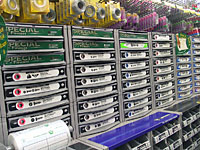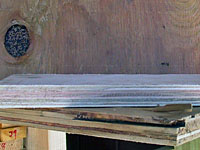

Obtaining Materials
Shopping for Lumber & Hardware

We will make sure that everything we use on this project for lumber and hardware is commonly available at larger hardware stores and lumber yards. It's a bit of a trip, but we seem to end up at one of the national big-box home improvement centers a several times a year (Lowes or Home Depot) and you should be able to get most items there. While small urban hardware stores might not carry all that you need, large suburban and rural hardware stores should have a good supplies of the hardware you need.
One good source of small parts, stainless steel and brass fasteners, knobs and tee-nuts are the "small parts drawers" found in many hardware stores. These are typically provided by the Hillman Group, and I have seen them in all the various hardware store franchises (Ace, Service Star, Do-It-Best, etc.)
Shopping for Telescope Parts
Mail order is probably your best choice, unless you live in one of the few major cities that have a store that carries such things. See our Links Page under the topic Suppliers for a list of vendors sorted by the type of parts they carry. The parts we are talking about here are mirrors, cells, diagonals, diagonal holders, spiders, focusers, eyepieces, finders, Teflon bearing pads and laminate in strips and small sheets.
Selecting Plywood for your Dobsonian

You need to use plywood to build your Dobsonian - particle board, strand board, OSB and other composites don't don't have the structural or ascetic qualities we need. Plywood comes in many grades, based on it's intended use:
- N: Natural, or cabinet grade, suitable for staining.
- A: Can be defect free or contain small knots, providing they are replaced with wooden plugs.
- B: Solid surface, but may contain small diameter knots and narrow surface splits. Normally repaired with wooden plugs or synthetic filler. The surface is normally sanded smooth.
- C: May contain tight knots up to 1½ inches diameter, some open knot holes, some face splits, and discoloration.
- D: May contain tight knots up to 1½ inches diameter, some open knot holes, some face splits, and discoloration.
The grade letters refer to each surface, so you will see sheet designations like N-N, A-B and C-D. Most softwood plywoods can also contain inner plies with unfilled knotholes, producing voids that sometimes splinter when cut and that leave unsightly gaps on cut edges. The plies are generally thick. Many cabinet grade plywoods (N-N grades) have many more thinner plys with no or very small voids (see photo). N grades are offered in many wood types: Oak, Maple, Birch and others (surface plys only). The premium brands of cabinet grade plywood are Baltic Birch and Appleply, they have nice thin plies (13 in ¾ inch) and no voids. The birch N-N plywood in the photo was purchased at a Home Depot in central Massachusetts, it is not a premium grade like Baltic Birch, and it has some voids. But it is a good compromise between cost and quality. There are also online retailers, such as Rockler, that sell premium cabinet grade plywoods by mail order.
I feel the C & D grades of plywood are not suitable for Dobsonian construction. If you plan to paint your telescope, you could certainly build it with A-B or B-C grade plywood; you may want or need to use wood filler to conceal defects. If you plan to stain your telescope, the N-N grades are certainly the best looking (The scope we build will use N-N ply wood), but you could use A-A, although the software out plies will not look quite as nice.
It used to be there were interior and exterior (waterproof) glue choices, but currently everything we have seen offered for sale has exterior glue ratings these days. Given the exterior use of your scope, don't buy interior only plywood if you find it.
Softwood plywood is sold in 4 foot by 8 foot sheets; home centers often sell partial sheets as "handy panels" in 4x4 and 2x4 subsections (at a markup for cutting). Sheet size for cabinet grades can be 4x8 or 5x5.
Rustproof Hardware
Your scope will be exposed to moisture, and ordinary hardware (the common zinc-plated steel) will eventually rust, which can stain you scope and looks unsightly. Whenever possible it is nice to use rustproof hardware: Brass, Stainless Steel or Plastic as appropriate. Brass and Stainless Steel parts cost more than standard, but since you will not need too many fasteners the cost will not be that great - consider using them. The small parts drawers mentioned above are a good place to find small quantities of rustproof fasteners.
Most people feel brass looks nice, but it is a soft metal and we have had screws break or screw slots deform, so we like to use the harder stainless steel parts for parts internal to the tube like mirror cells. For items that attach though the tube or are very visible on the mount, we often choose brass (and tighten carefully).
Previous: Anatomy of a Dobsonian
Next: Sawing, Shaping, Drilling & Sanding
Back to the Build a Dobsonian Master Index